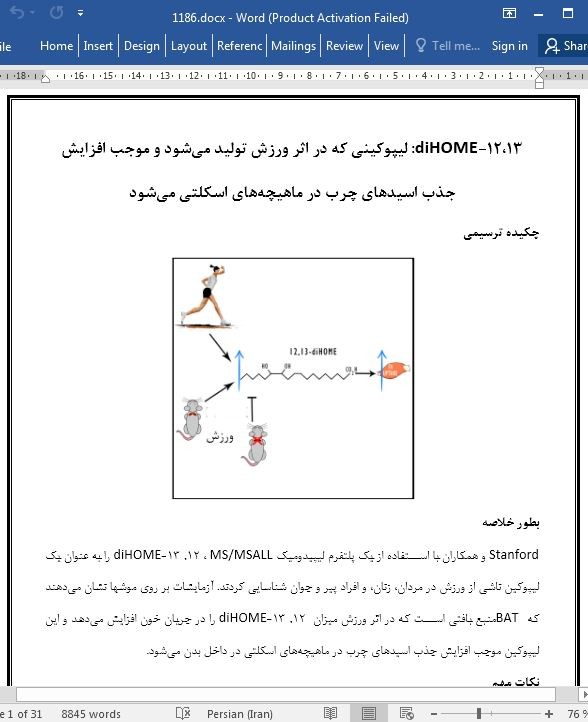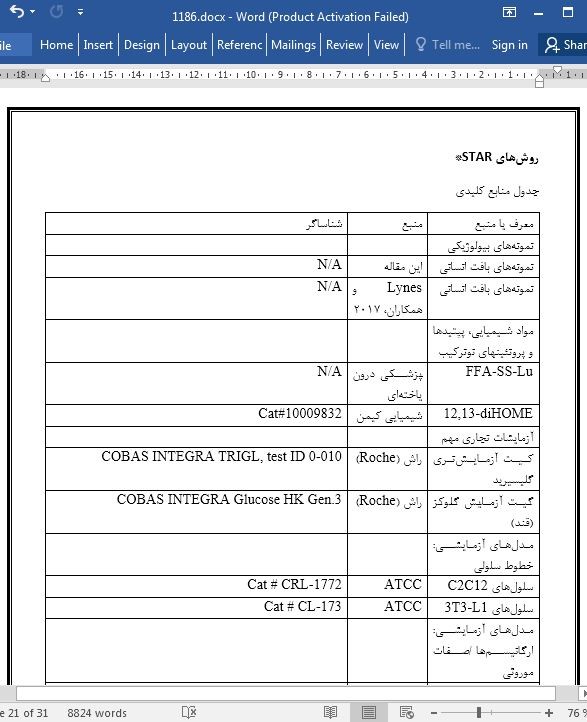
12,13-diHOME: لیپوکین تولید شده با ورزش کردن و افزایش جذب اسیدهای چرب در ماهیچههای اسکلتی
خلاصه
فرض بر این است که عوامل موجود در گردش خون که در طی ورزش از بافتها آزاد میشوند، رابطه غیر مستقیمی با برخی از مزایای سلامتی داشتن فعالیت بدنی منظم دارند. لیپوکینها، گونههای لیپید موجود در جریان خون هستند که اخیراً گزارش شده است در واکنش به سرما بر متابولیسم بدن تأثیر میگذارند. در اینجا ، تجزیه و تحلیل لیپیدومیک نشان داد که ورزش کردن با شدت متوسط میتواند موجب افزایش قابل توجهی در میزان چربی خون 12,13-dihydroxy-9Zoctadecenoic acid (12,13-diHOME) در مردان، زنان، پیر و جوان، و افراد کم تحرک و فعال شود. در موشها، انجام یک دور ورزش و همچنین تمرینات ورزشی موجب افزایش 12,13-diHOME در جریان خون شد و برداشتن بافت چربی قهوهای (BAT)توسط جراحی این افزایش در 12,13-diHOME را خنثی کرد و این امر حاکی از این بود که BAT یک منبع بافتی برای تحریک تولید 12،13 DiHOME- در اثر ورزش است. درمان 12،13diHOME- موشها حاد در بدن موشها موجب افزایش جذب و اکسیداسیون اسیدهای چرب در ماهیچههای اسکلتی شد، اما در جذب گلوکر افزایشی ایجاد نکرد. این دادهها نشان میدهد که لیپوکینها عوامل جدید موجود در جریان خون هستند که در اثر ورزش تولید میشوند و میتوانند به تغییرات متابولیکی که با تمرینات بدنی صورت میگیرند کمک کنند.
مقدمه
ورزش تقریباً منجر به سازگاری تمام بافتهای بدن میشود، و این تغییرات به اثرات مفید ورزش در بهبود سلامت متابولیک کمک میکنند. حتی انجام یک دور تمرین با شدت متوسط میتواند اثرات قابل توجهی بر متابولیسم گلوکز، و کاهش تراکم انسولین در خون داشته باشد و ماهیچههای اسکلتی را نسبت به انسولین حساستر کند (Goodyear و Kahn، 1998). تمرین ورزشی که به عنوان دورهای مکرر ورزش در طی یک هفته ، ماه یا سال تعریف میشود، نیز میتواند منجر به کاهش تراکم انسولین و بهبود تحمل گلوکز شود (Egan و Zierath، 2013؛ Goodyear و Kahn، 1998). اخیراً توجه زیادی نسبت به شناسایی عوامل جدید موجود در گردش خون نشان داده شده است که رابطه غیر مستقیمی با تاثیرات سودمند ورزش بر سلامتی دارند. بیشتر این تمرکز بر روی بررسی عوامل تولید شده در عضله، به نام میوکین ها بوده است (Pedersen و Febbraio، 2008)، و ما و دیگران نیز فرض کردهایم که آدیپوکینهای تولید شده در اثر ورزش ممکن است برخی از فواید ورزش بر سلامتی را به همراه داشته باشند (Stanford و Good year، 2016، Stanford و همکاران، 2015a).
Summary
Circulating factors released from tissues during exercise have been hypothesized to mediate some of the health benefits of regular physical activity. Lipokines are circulating lipid species that have recently been reported to affect metabolism in response to cold. Here, lipidomics analysis revealed that a bout of moderate-intensity exercise causes a pronounced increase in the circulating lipid 12,13-dihydroxy-9Z-octadecenoic acid (12,13-diHOME) in male, female, young, old, sedentary, and active human subjects. In mice, both a single bout of exercise and exercise training increased circulating 12,13-diHOME and surgical removal of brown adipose tissue (BAT) negated the increase in 12,13-diHOME, suggesting that BAT is the tissue source for exercise-stimulated 12,13-diHOME. Acute 12,13-diHOME treatment of mice in vivo increased skeletal muscle fatty acid uptake and oxidation, but not glucose uptake. These data reveal that lipokines are novel exercise-stimulated circulating factors that may contribute to the metabolic changes that occur with physical exercise.
INTRODUCTION
Exercise results in adaptations to almost all tissues in the body, and these changes contribute to the beneficial effects of exercise to improve metabolic health. Even a single bout of moderate-intensity exercise can have dramatic effects on glucose metabolism, lowering circulating insulin concentrations and making skeletal muscles more sensitive to insulin (Goodyear and Kahn, 1998). Exercise training, defined as repeated bouts of exercise over a period of weeks, months, or years, can also result in lowering of insulin concentrations and improve glucose tolerance (Egan and Zierath, 2013; Goodyear and Kahn, 1998). Recently there has been great interest in identifying novel circulating factors that mediate the beneficial effects of exercise on health. Most of this focus has been on the investigation of muscle-derived factors, known as myokines (Pedersen and Febbraio, 2008), and we and others have also hypothesized that there may be exercise-stimulated adipokines that mediate some of the benefits of exercise on health (Stanford and Goodyear, 2016; Stanford et al., 2015a).
چکیده ترسیمی
بطور خلاصه
نکات مهم
خلاصه
مقدمه
نتایج و بحث
تاثیرات میزان فعالیت بر 12،13 DiHOME-تولید شده در اثر ورزش
راکد بودن تراکم 12،13 DiHOME- با توده چربی مرتبط است
12،13 DiHOME- با انجام ورزش در موشها افزایش یافت
BAT یک منبع بافتی برای افزایش تولید 12،13 DiHOME-در خون در اثر ورزش است
12،13 DiHOME جذب اسیدهای چرب در ماهیچههای اسکلتی را در بدن افزایش میدهد
12،13 DiHOME تنفس میتوکندریایی را در سلولهای عضلانی افزایش میدهد
عملکرد و مکانیسم افزایش 12،13 DiHOME با تمرینات ورزشی
12،13 DiHOME با تنفس بیشتر ماهیچههای اسکلتی در انسان مرتبط است
12،13 DiHOME بر جذب گلوکز ماهیچه اسکلتی تاثیری ندارد
محدودیتهای مطالعه
روشهای STAR
روشهای STAR
تماس برای معرف و اشتراک گذاری منبع
مدل آزمایشی و جزئیات مربوط به اشخاص مطالعه
اشخاص انسانی
جانوران
کشت سلول
جزئیات روش
تست و نظارت بر ورزش انسانی
موش و ورزش
برداشت iBAT-
جذب اسیدهای چرب در بدن
مطالعات متابولیک
جذب [3H]-2-deoxyglucose در ماهیچه اسکلتی
پروفایل بندی لیپودمی
مطالعات سلولی و PCR
جذب گلوکز در سلولهای C2C12
تحلیل کیفی و آماری
آمار
منابع
Graphical Abstract
Highlights
In Brief
SUMMARY
INTRODUCTION
RESULTS AND DISCUSSION
12,13-diHOME Is an Exercise-Induced Lipokine in Humans
Effects of Activity Level on Exercise-Stimulated 12,13-diHOME
Resting 12,13-diHOME Concentrations Are Correlated with Fat Mass
12,13-diHOME Is Increased with Exercise in Mice
BAT Is the Tissue Source for the Exercise-Induced Increase in Circulating 12,13-diHOME
12,13-diHOME Increases Skeletal Muscle Fatty Acid Uptake In Vivo
12,13-diHOME Increases Mitochondrial Respiration in Muscle Cells
Function and Mechanism of Increased 12,13-diHOME with Exercise Training
12,13-diHOME Correlates to Greater Skeletal Muscle Respiration in Humans
12,13-diHOME Does Not Affect Skeletal Muscle Glucose Uptake
Limitations of Study
STAR+METHODS
STAR+METHODS
CONTACT FOR REAGENT AND RESOURCE SHARING
EXPERIMENTAL MODEL AND SUBJECT DETAILS
Human Subjects
Animals
Cell Culture
METHOD DETAILS
Human Exercise Testing and Monitoring
Mice and Exercise
Removal of iBAT
In Vivo Fatty Acid Uptake
Metabolic Studies
Skeletal Muscle [3 H]-2-deoxyglucose Uptake
Lipidomic Profiling
PCR and Cell Studies
Glucose Uptake in C2C12 Cells
QUANTIFICATION AND STATISTICAL ANALYSIS
Statistics
REFERENCES
- اصل مقاله انگلیسی با فرمت ورد (word) با قابلیت ویرایش
- ترجمه فارسی مقاله با فرمت ورد (word) با قابلیت ویرایش، بدون آرم سایت ای ترجمه
- ترجمه فارسی مقاله با فرمت pdf، بدون آرم سایت ای ترجمه



